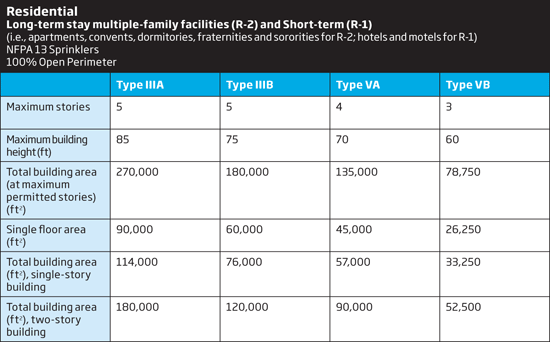Multi-Story Wood Construction
Building Code Requirements
The IBC is the predominant U.S. model building code, having been adopted by most states with or without amendments. Chapters 16, 17 and 23 cover structural wood design and construction. (Non-structural provisions such as heights and areas are covered elsewhere.) The IBC classifies buildings into five types of construction. Construction Types I and II are generally limited to non-combustible materials such as concrete and steel, although wood can be used in all types of construction to varying degrees. Type III allows a mix of non-combustible and combustible materials, while construction Types IV and V can have combustible building materials.
Multi-story wood construction generally falls under Types III and V. (However, Type IV multi-story construction, also known as Heavy Timber, is growing in interest.) Each building type is further subdivided into A and B, which have different fire-resistance rating requirements, with A being the more rigorous. (See section: Fire Protection Requirements.) “From a cost perspective it makes no sense to use Type I for five stories,” says Tim Smith, AIA, founding principal of Togawa Smith Martin, Inc., Los Angeles, and a pioneer of five-story wood framing in California. “Type I is more realistic for taller buildings. Type III for wood construction helps fill the gap between low-rise and taller buildings.”
Permissible Increases in Area and Height
Table 503 of the IBC lists allowable building heights and floor areas for different construction types; however, there are provisions for increases. For Type IIIA, for instance, an allowable floor area of 24,000 square feet as stipulated in Table 503 for Group R-2 occupancies could be increased to 90,000 square feet per story. Such provisions include:
Open front areas. IBC Section 506.2 permits area increases up to 75 percent for buildings with open spaces around their perimeters such as yards, courts, parking areas and streets, which provide fire-fighting access.
Sprinkler systems. For most occupancy groups, increases to the allowable height (and number of stories) and floor area are permitted according to IBC Section 504.2 with the use of an approved automatic sprinkler system in accordance with the National Fire Protection Association (NFPA) 13 standard.

Source: American Wood Council
IBC allowable heights and areas for residential wood construction
“Type IIIA construction for Residential Group R is allowed to be four stories and 65 feet high while a Type VA building is permitted to be three stories and 50 feet,” explains Kevin Cheung, Ph.D., P.E., chief engineer for the Western Wood Products Association. “However, when protected by automatic sprinklers, Type IIIA and Type VA buildings are allowed to be five and four stories, respectively. Type IIIA is permitted an increase in height to 85 feet and Type VA an increase to 70 feet.” (See Table of IBC Allowable Heights and Areas for Residential Construction.)
In the Pacific Northwest (Washington, Oregon and Idaho), the model code has been amended to allow Type V residential buildings to have up to five stories of wood-frame construction with additional limitations. In Canada, the British Columbia building code was revised in 2009 to permit residential wood construction up to six stories.
Use of fire walls to “separate” buildings. While the code does not explicitly require fire walls, they may be utilized in many cases to expand the prescribed size of a building. (See Parkside sidebar on page 4.) IBC Section 706.4 requires a three-hour rating for R-2 (long-term residential) occupancy of Type IIIA construction.
IBC Section 706 permits portions of a building separated by one or more fire walls to be considered as separate, side-by-side buildings. In this way, wood-frame buildings can be designed as separate but connected buildings for code-compliance purposes. This partitioning allows wood buildings to be unlimited in size.
Mezzanines. IBC Section 505 excludes mezzanines from the determination of number of stories or building area. Mezzanines may be one-third of the floor area of the room or space beneath. For example, a loft or penthouse plus a mezzanine on the first concrete podium floor could add two “stories” to the building.
Podium design. In order to gain an additional story for multi-level wood-framed buildings, architects and engineers are increasingly turning to podium or pedestal design rather than building directly on a concrete slab on grade. Section 510.2 of the 2012 IBC allows five- or six-story wood-frame structures over one level of typically concrete Type IA construction. These “five-over-one” and “six-over-one” buildings are treated in the code as two structures separated by a three-hour fire-resistance-rated horizontal assembly. The podium is considered as a separate and distinct building for the purpose of determining height and area limitations and vertical continuity of fire walls. The overall height of the two buildings together is measured from grade plane, and the height limitations of Chapter 5 apply. The 2015 IBC will expand this opportunity by allowing two or more stories below the three-hour horizontal fire assembly with the caveat that the overall building height from grade still not exceed the limits set out in Chapter 5.









